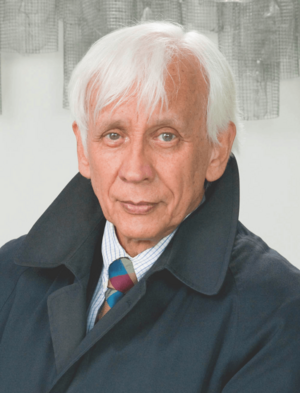Rodolfo Llinás facts for kids
Quick facts for kids
Rodolfo Llinás
|
|
|---|---|
| Rodolfo Llinás Riascos | |
 |
|
| Born | 16 December 1934 Bogotá, Colombia
|
| Nationality | Colombian and American |
| Alma mater | Pontificia Universidad Javeriana and Australian National University |
| Known for | Physiology of the cerebellum, the thalamus, Thalamocortical dysrhythmia as well as for his pioneering work on the inferior olivary nucleus, on the squid giant synapse and on human magnetoencephalography (MEG) |
| Awards | Ralph W. Gerard Prize (2018) |
| Scientific career | |
| Fields | Neuroscience |
| Institutions | NYU School of Medicine |
| Doctoral advisor | Sir John Eccles |
Rodolfo Llinás Riascos (born December 16, 1934) is a famous Colombian neuroscientist. A neuroscientist is a scientist who studies the brain and nervous system. He is currently a top professor at the NYU School of Medicine in New York City. Dr. Llinás has written more than 800 scientific papers about his research.
Contents
Early Life and Inspiration
Rodolfo Llinás was born in Bogotá, Colombia. His father, Jorge Enrique Llinás, was a surgeon. His mother was Bertha Riascos. Rodolfo became interested in studying the brain by watching his grandfather, Pablo Llinás Olarte. His grandfather was a neuropsychiatrist, a doctor who treats mental illnesses related to the brain.
Education and Early Discoveries
Llinás went to school in Bogotá and became a medical doctor in 1959. During his medical studies, he traveled to Europe. There, he met important researchers, including Dr. Walter Rudolf Hess in Switzerland. Dr. Hess had won a Nobel Prize for his work on the brain.
Llinás earned his PhD in 1965 from the Australian National University. He worked with Sir John Eccles, another Nobel Prize winner.
Personal Life and Interests
After finishing his studies in Australia, Rodolfo Llinás was very interested in how the brain creates our thoughts and feelings. He met his future wife, Gillian Kimber, who was studying philosophy. His two sons, Rafael and Alexander, also became doctors.
Dr. Llinás also helped create an interactive science museum in Bogotá, Colombia, called Maloka Museum. In 2018, he gave a T-Rex skeleton to the museum. He also helped design a model of the dinosaur's nervous system for the exhibit.
What He Studied
Dr. Llinás has spent his career studying how individual neurons (brain cells) work. He looked at different parts of the brain, like the cerebellum (which helps with movement) and the thalamus (which processes sensory information).
He also studied how brain cells communicate. He used the squid giant synapse, which is a very large connection between two neurons in a squid. This allowed him to see how signals are sent. He also studied human brain function using magnetoencephalography (MEG). This is a way to measure the tiny magnetic fields produced by brain activity.
His Career Journey
Dr. Llinás has held many important positions throughout his career. He worked at several universities and research institutes. These include Harvard University, the University of Minnesota, Northwestern University, and the University of Iowa.
Since 1976, he has been a professor at New York University (NYU). He was the chairman of the Department of Physiology and Biophysics there for many years. He is now a University Professor at NYU, continuing his research and teaching.
Important Discoveries
Dr. Llinás has made many important discoveries in neuroscience. Here are some of his key contributions:
- He found out how some brain cells can stop other brain cells from sending signals.
- He helped us understand how the cerebellar cortex (part of the cerebellum) works.
- He showed that some vertebrate neurons can create special electrical signals using calcium.
- He helped organize the NASA Neurolab Project. This project studied how the brain and nervous system are affected by space travel.
- He discovered a special type of calcium channel in brain cells called Purkinje cells.
- He found that certain brain cells in the inferior olive and thalamus can generate unique electrical signals.
- He used magnetoencephalography (MEG) to study brain function in people.
- He discovered Thalamocortical dysrhythmia. This is a theory about how abnormal brain rhythms in the thalamus and cortex might be linked to certain brain disorders.
Awards and Recognition
Dr. Llinás is a member of several important scientific groups. These include the United States National Academy of Sciences and the American Academy of Arts and Sciences. He has also received honorary degrees from many universities around the world.
He has received many awards for his work, including:
- The UNESCO Albert Einstein medal (1991)
- The Order of Boyaca from the President of Colombia (1992)
- The Bernard Katz Award (2012)
- The Ralph W. Gerard Prize in Neuroscience (2018), which is a very high honor in neuroscience.
In 2013, the NYU Neuroscience Institute started the Annual Rodolfo Llinás Lecture Series. This honors his amazing contributions to understanding the brain.
Film About His Work
- Llinas, el cerebro y el universo (Llinas, the Brain and the Universe). This is a documentary film about his life and work, released in 2018.
See also
 In Spanish: Rodolfo Llinás para niños
In Spanish: Rodolfo Llinás para niños

